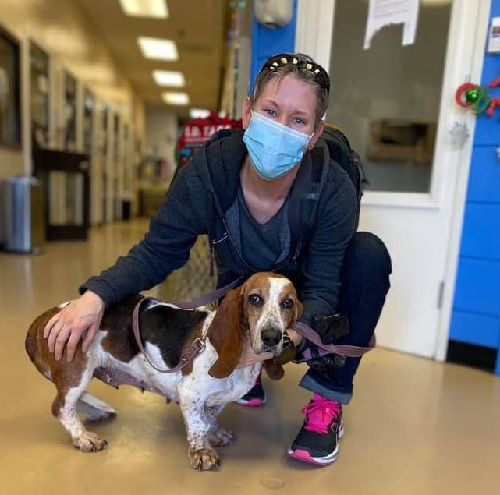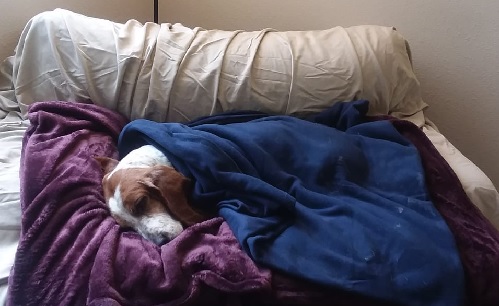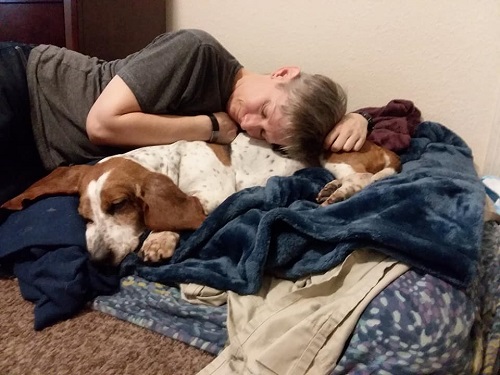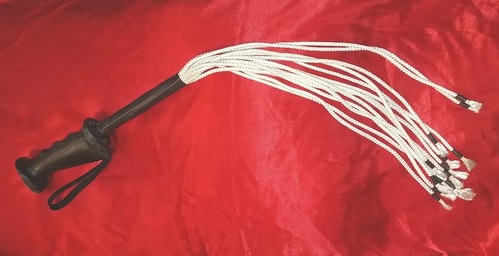I never doubted that I was doing the right thing when I drove over 10 hours round trip to adopt a seven-year-old basset hound on December 30, 2020. The moment I saw Faith’s photo, I knew she was my dog.
Five days after her adoption, I rushed Faith to the animal hospital in renal failure. Until then, no one had realized how sick she was.

During her first hospitalization, the vet determined that Faith would need to be on prescription food for the rest of her life.
Ok, I thought. I can do that.
About a week later, she had to be hospitalized again. During that stay, the vet determined she would need to be on subcutaneous fluids every night for the rest of her life.
Ok, I thought. I can do that too.
They had to bring me into the hospital so the tech could teach me how to put the needle in her back between her shoulder blades. As I sat on the floor with Faith with one of her vets sitting on the floor across the room from us, we discussed her medical conditions. He had been employed at the hospital for about six months, but because of COVID, I was the first pet parent he’d spoken to in person.
Every day while Faith was hospitalized, I called the hospital at 4:30am to ask how she was doing as I drank my morning coffee. I knew the vet would call after morning rounds, but I didn’t want to wait to hear how my baby was doing. When the staff mentioned in passing that she liked the fleece blanket, I went to Target and bought her four. I wanted her to be surrounded by loving softness.
One of her fleeces, “purple blanket,” even came with us to the office every day. At the end of each day, I’d scoop up Faith’s 33-pound body and carry her to the car. At night, I administered her subcutaneous fluids. Each of her beds had one of her heavy fleece blankets, and I hung a hook on the wall above each one for the fluid bag. After she was done with her fluids, I covered her with a light fleece and the heating pad to keep her warm as her body absorbed the room temperature fluid.

I was prepared to do whatever she needed.
I wasn’t prepared to say goodbye so soon.
On January 31, 2021, as I was about to climb into bed, I noticed that Faith was breathing somewhat rapidly. I called the hospital and they said to bring her in. As I pulled into the parking lot, I was met by three techs. Two of them loaded Faith onto a stretcher and whisked her inside, and one handed me a clipboard with a consent form. I climbed into the back seat and tried to sleep, knowing it would be a while before the vet called with an update. Close to midnight, my phone rang. Not only were Faith’s kidney numbers worse than ever, she also had pneumonia. Her little body was failing.
The vet offered to put her down that night, but I declined. “Faith will die at home,” I said.

Faith and I went to the office on Faith’s last full day. I invited the legal assistant who adored Faith to come pet her before we left for the day. She was busy and said something like, “I’ll see her next time.”
With tears welling in my eyes I responded, “There isn’t going to be a next time.”
That night, Faith and I cuddled on the couch with purple blanket and watched “The Devil Wears Prada.” The next morning, Dr. Katherine Campabadal came to the house and helped little Faith over the Rainbow Bridge. Just like with Rosie, I stayed at Faith’s side through to the end, and then kept her home for a few hours until I was ready to take our final photos before taking her to the pet mortuary.

Faith died on February 3, 2021, only 36 days after her adoption. I didn’t know it when I adopted her, but my job was to give her a soft place to land and surround her with love for her final days.


